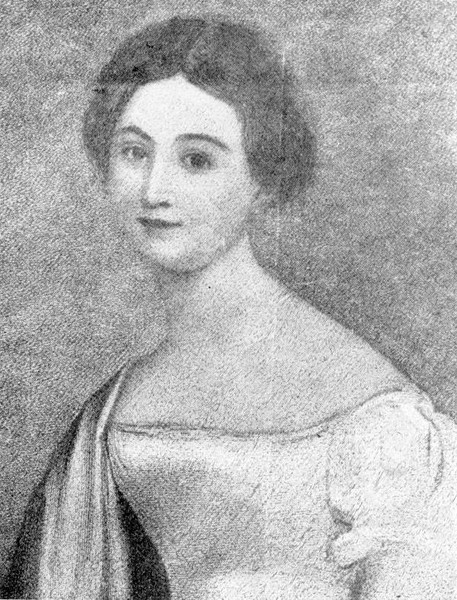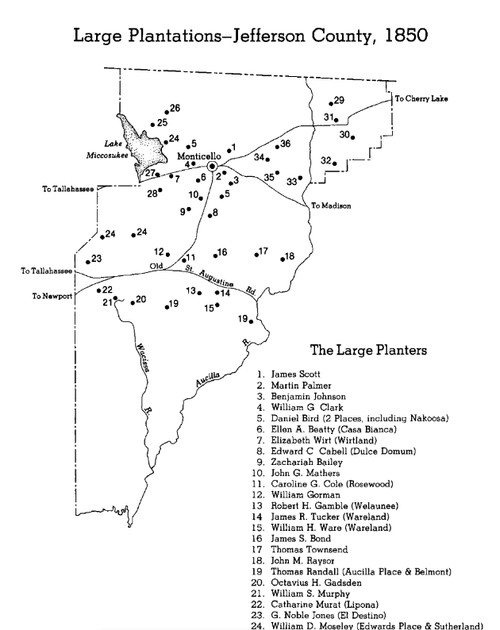Lipona Plantation
Introduction
Text-to-speech Audio
The location pinpointed is a guesstimation based on a hand-drawn map. Lipona Plantation was a cotton plantation of 900 acres (3.6 km2) in Jefferson County, Florida, United States, established by Prince Achille Murat. The name is an anagram of Napoli, which Murat was the former prince of. The Lipona Plantation was situated approximately 15 miles east of Tallahassee, Florida. Its prominent feature was a two-story, wood-frame plantation house, which boasted a grand portico that added to its allure. The plantation encompassed several outbuildings, including a barn, a smokehouse, and a kitchen, providing essential spaces for daily operations.
Like many plantations of its time, Lipona relied on the labor of enslaved individuals to sustain its operations. Enslaved people formed the workforce, toiling in the fields and performing various tasks necessary for the plantation's functioning. Their labor contributed to the production of cotton, corn, and sugarcane, which were key crops cultivated on the plantation.
With the end of the Civil War and the abolition of slavery, the plantation was abandoned, signaling a profound shift in the economic and social landscape of the region. The changing times brought about significant changes in the plantation system, rendering many plantations obsolete.
Today, the land once occupied by the Lipona Plantation has become part of the Apalachicola National Forest. The transformation of the plantation into a national forest reflects the evolving attitudes towards land use and conservation, preserving the area's natural beauty and providing recreational opportunities for visitors to enjoy.
Images
Painted portrait of Catherine Murat


Plantations of Jefferson County Florida

Backstory and Context
Text-to-speech Audio
Achille's plantation in Jefferson County, Florida, at the time of his marriage, was called the Lipona, which had first been used by his mother, Caroline Bonaparte, after her husband's death as a nod to the crown she had once held. And so he honored his birthplace and his mother with the name.
Though only a single-story, two-room cabin at first, Lipona quickly expanded, eventually entailing four buildings around a central garden, in addition to an added second story on the original cabin. Despite their modest appearance, guests found inside golden utensils, fine linen sheets, and a marble bust of Caroline Bonaparte by the Italian artist Casova.
Taught well by her mother, Kate was an excellent hostess, navigating her husband’s eccentricities with ease. For example, Achille was a well-known omnivore who would proudly boast he had eaten every creature and plant he could shoot or pick. He enjoyed owls, cooked whole, frogs, and alligators. However, the turkey buzzard was not good. He claimed to have stewed, fried, and boiled it, put it in a soup, and he just couldn't find a way to make it good. OK, knowing what her husband might serve, is said to have warned guests at their dinner parties against accepting dishes from her husband's side of the table.
Kate and Achille, though childless, by every report, had a very happy marriage. They entertain frequently at Lipona, hosting the “gentry” of Tallahassee, despite financial struggles. Another example of Kate’s tolerance of his way of thinking is common in many sources. One morning Achille convinced Kate to visit friends, which she did. Upon returning home, however, she found Achille stirring a large cauldron over a bonfire. “Oh, Kate! I’ve dyed all your dresses the most beautiful pink!” Experimenting with a pokeberry plant, he’d gathered everything he could find that was made of cloth and dyed it a lurid shade of pink, proudly. Catherine, rather than becoming angry, instead laughed herself exhausted. One does was described as a "dress grandmothers brag to their granddaughters about having seen," and it was declared that its equal had not been seen in this country since. By 1830, Lipona was large enough to have its own post office, with Achille as its postmaster. That same year, Achille's hope of his family's restoration to power nearly came true or seemed like it would, and he and Kate journeyed to Europe, where they would travel around for four years before returning to Lipona. In order to find these travels, Achille mortgaged the plantation, hoping to get the money for repayment while in Europe.
Patsy became Kate's maid at Lipona. Her duties as a house servant would have included helping Kate, doing chores around the house, such as sweeping the hearth and keeping the chamber pots empty, or even helping to cook when needed. We don't know much about the details of Patsy’s life during this, or any, period. We must, once again, rely on averages and other accounts of enslavement for an idea of what her life must have been like.
Sources
Smith, Julia Floyd. Slavery and Plantation Growth in Antebellum Florida 1821-1860. Gainesville, Florida: LibraryPress@UF, 2017.
McConnell, Matilda L. “Interesting Incidents in Life of Prince Murat.” The Tallahassee Democrat. June 8, 1922.
“Princess Murat.” The New Orleans Weekly Delta, June 27, 1852.
Hanna, A. J. A Prince In Their Midst: The Adventurous Life of Achille Murat on the American Frontier. Norman, OK: University of Oklahoma Press, 1946.
Walden, Ann. “A Princess Lived at Bellevue.” The Tampa Tribune, May 21, 1961.
Boyle, Hallie. “Socks and Cannons and Princess Murat.” The Tallahassee Democrat, August 6, 1967.
Painted portrait of Princess Catherine Willis Gray Murat - Tallahassee, Florida. 1870 (circa). State Archives of Florida, Florida Memory. <https://www.floridamemory.com/items/show/24860>, accessed 20 May 2023
Florida Memory
The Red Hills of Florida 1528-1865
